Patient Experience and Partnering in Care: An Analysis and Action Plan
VerifiedAdded on 2023/06/04
|9
|2343
|207
Essay
AI Summary
This essay delves into the critical aspects of patient experience and partnering in care within modern healthcare settings. It emphasizes the integral role of nurses in enhancing patient experiences and ensuring safety through key values such as caring, compassion, and integrity. The essay examines strategies for improving patient experiences, including efficiency in clinical settings, prompt care provision, and providing sufficient information for informed patient decisions. Through a case study involving Mr. Taylor, the essay explores the impact of delays, the importance of compassionate care, and the influence of nursing values on patient outcomes. It analyzes the causes of delays, such as understaffing and ineffective decision-making, while highlighting the significance of professionalism, teamwork, and effective communication. The essay concludes with an action plan focused on process improvements, increased staffing, and enhanced communication to create a more positive and satisfactory patient experience, recognizing the vital link between positive experiences and patient trust in healthcare systems.
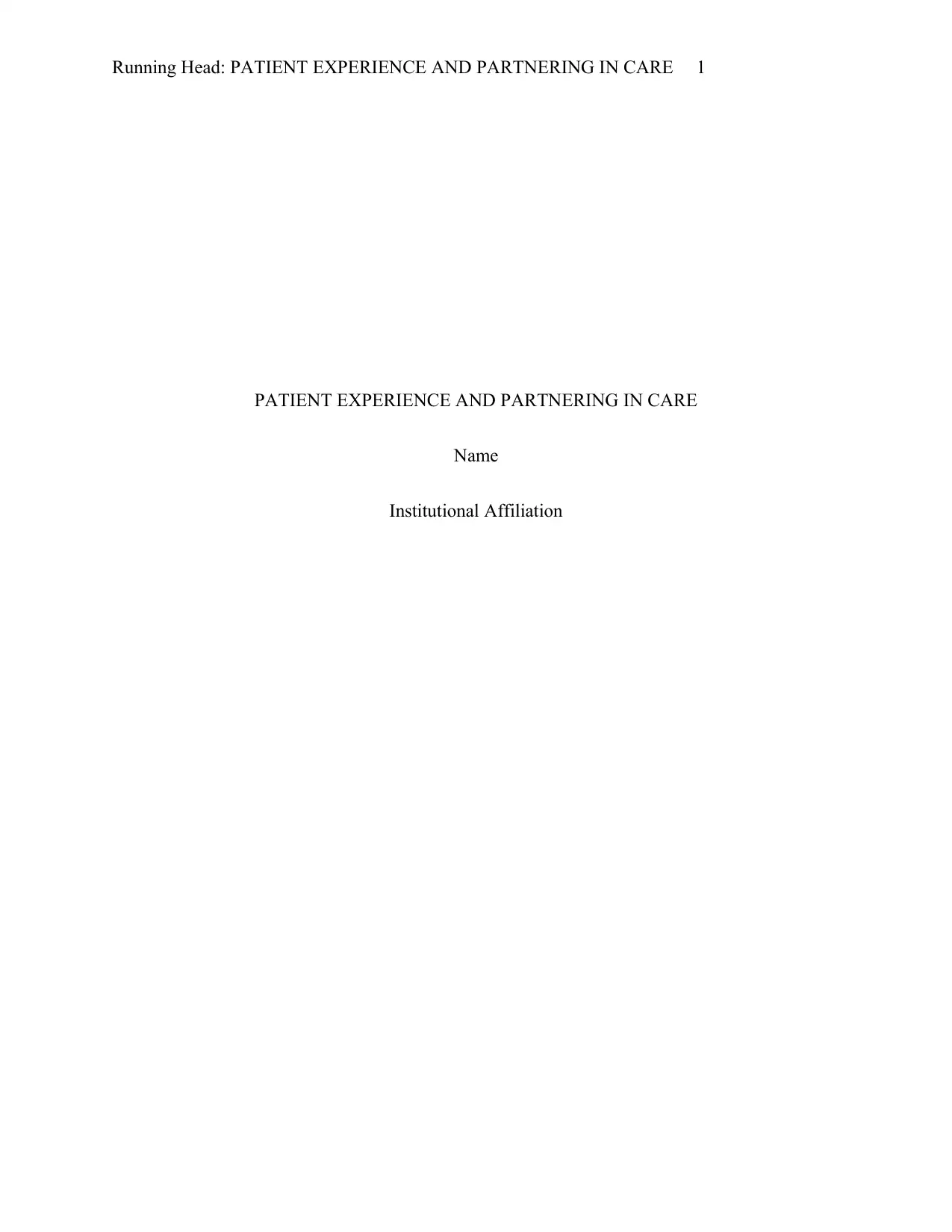
Running Head: PATIENT EXPERIENCE AND PARTNERING IN CARE 1
PATIENT EXPERIENCE AND PARTNERING IN CARE
Name
Institutional Affiliation
PATIENT EXPERIENCE AND PARTNERING IN CARE
Name
Institutional Affiliation
Paraphrase This Document
Need a fresh take? Get an instant paraphrase of this document with our AI Paraphraser
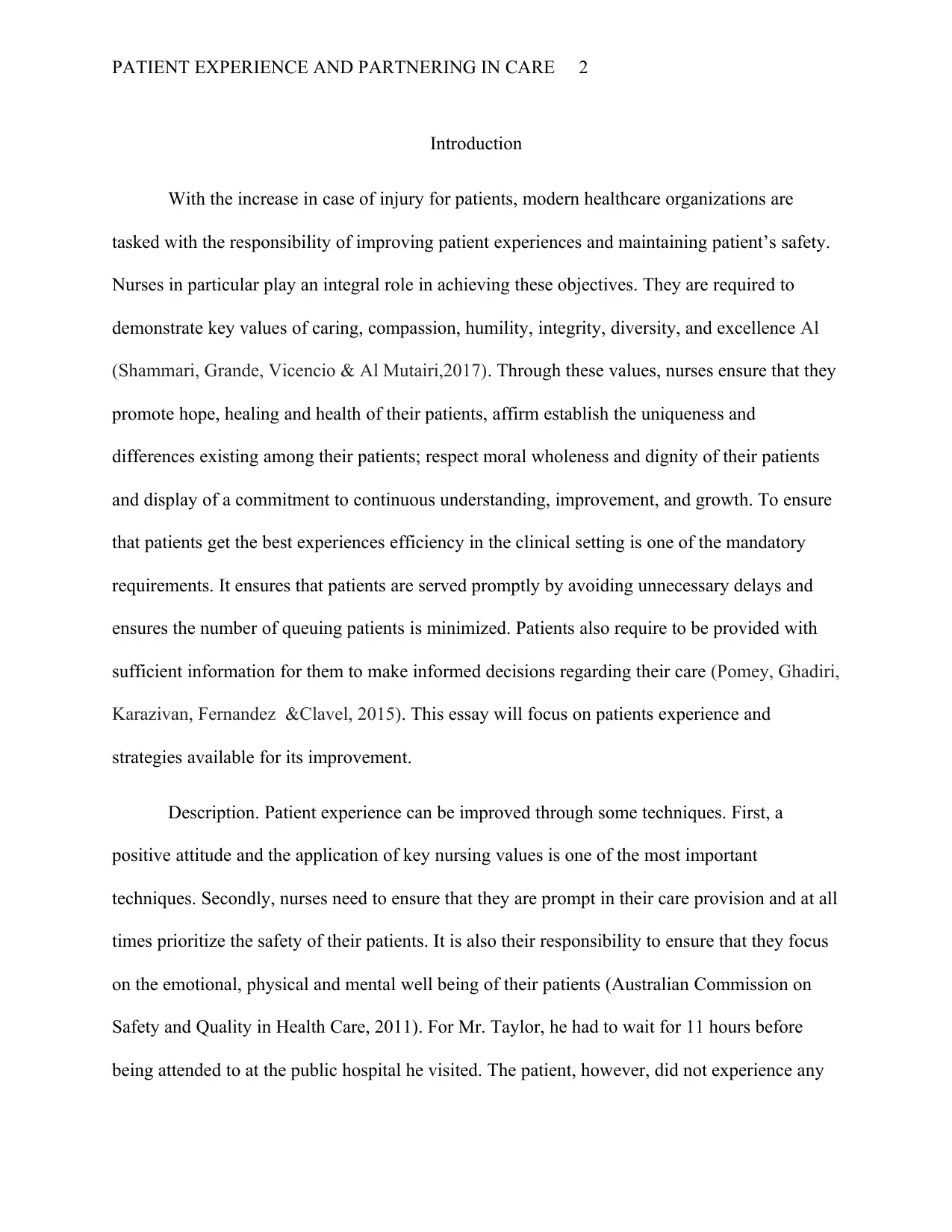
PATIENT EXPERIENCE AND PARTNERING IN CARE 2
Introduction
With the increase in case of injury for patients, modern healthcare organizations are
tasked with the responsibility of improving patient experiences and maintaining patient’s safety.
Nurses in particular play an integral role in achieving these objectives. They are required to
demonstrate key values of caring, compassion, humility, integrity, diversity, and excellence Al
(Shammari, Grande, Vicencio & Al Mutairi,2017). Through these values, nurses ensure that they
promote hope, healing and health of their patients, affirm establish the uniqueness and
differences existing among their patients; respect moral wholeness and dignity of their patients
and display of a commitment to continuous understanding, improvement, and growth. To ensure
that patients get the best experiences efficiency in the clinical setting is one of the mandatory
requirements. It ensures that patients are served promptly by avoiding unnecessary delays and
ensures the number of queuing patients is minimized. Patients also require to be provided with
sufficient information for them to make informed decisions regarding their care (Pomey, Ghadiri,
Karazivan, Fernandez &Clavel, 2015). This essay will focus on patients experience and
strategies available for its improvement.
Description. Patient experience can be improved through some techniques. First, a
positive attitude and the application of key nursing values is one of the most important
techniques. Secondly, nurses need to ensure that they are prompt in their care provision and at all
times prioritize the safety of their patients. It is also their responsibility to ensure that they focus
on the emotional, physical and mental well being of their patients (Australian Commission on
Safety and Quality in Health Care, 2011). For Mr. Taylor, he had to wait for 11 hours before
being attended to at the public hospital he visited. The patient, however, did not experience any
Introduction
With the increase in case of injury for patients, modern healthcare organizations are
tasked with the responsibility of improving patient experiences and maintaining patient’s safety.
Nurses in particular play an integral role in achieving these objectives. They are required to
demonstrate key values of caring, compassion, humility, integrity, diversity, and excellence Al
(Shammari, Grande, Vicencio & Al Mutairi,2017). Through these values, nurses ensure that they
promote hope, healing and health of their patients, affirm establish the uniqueness and
differences existing among their patients; respect moral wholeness and dignity of their patients
and display of a commitment to continuous understanding, improvement, and growth. To ensure
that patients get the best experiences efficiency in the clinical setting is one of the mandatory
requirements. It ensures that patients are served promptly by avoiding unnecessary delays and
ensures the number of queuing patients is minimized. Patients also require to be provided with
sufficient information for them to make informed decisions regarding their care (Pomey, Ghadiri,
Karazivan, Fernandez &Clavel, 2015). This essay will focus on patients experience and
strategies available for its improvement.
Description. Patient experience can be improved through some techniques. First, a
positive attitude and the application of key nursing values is one of the most important
techniques. Secondly, nurses need to ensure that they are prompt in their care provision and at all
times prioritize the safety of their patients. It is also their responsibility to ensure that they focus
on the emotional, physical and mental well being of their patients (Australian Commission on
Safety and Quality in Health Care, 2011). For Mr. Taylor, he had to wait for 11 hours before
being attended to at the public hospital he visited. The patient, however, did not experience any
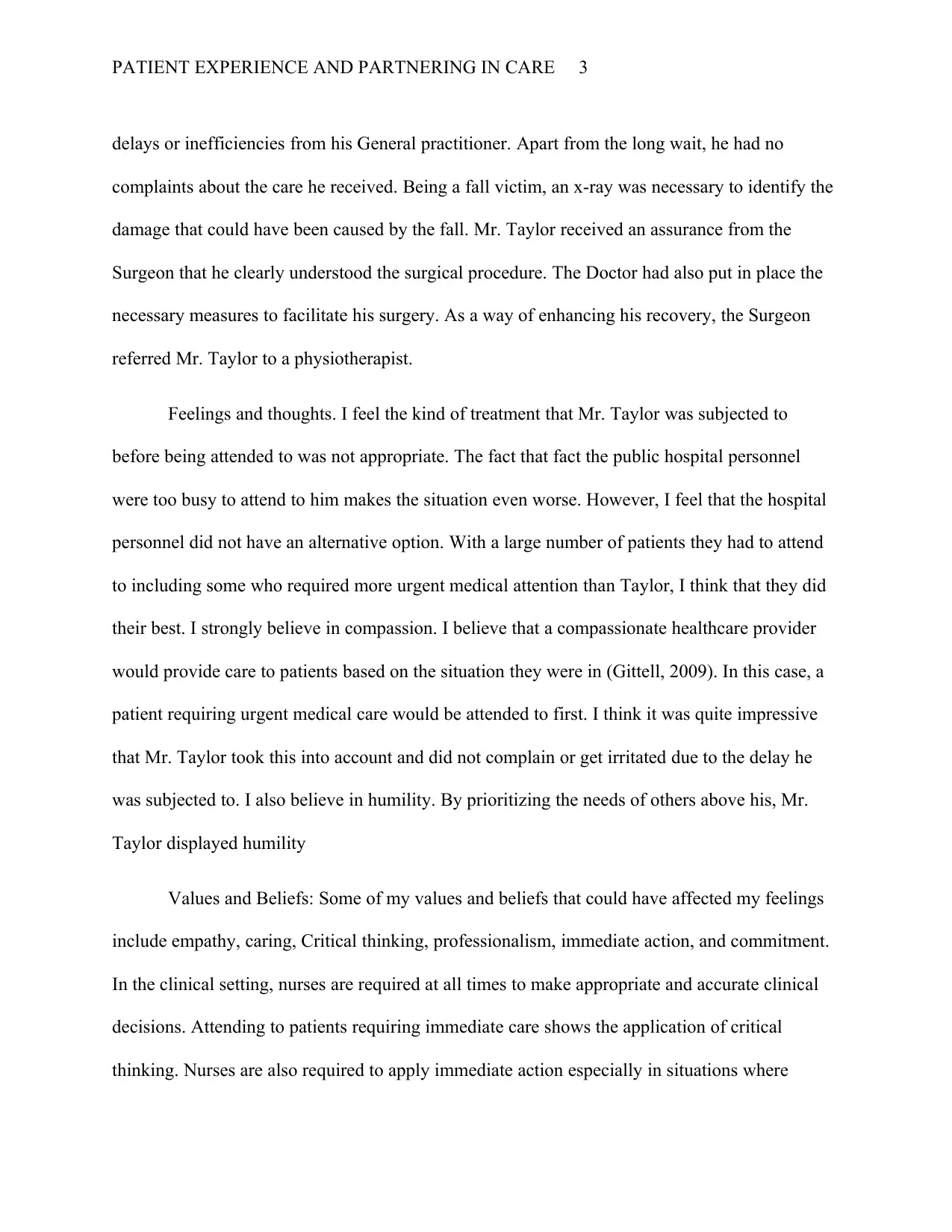
PATIENT EXPERIENCE AND PARTNERING IN CARE 3
delays or inefficiencies from his General practitioner. Apart from the long wait, he had no
complaints about the care he received. Being a fall victim, an x-ray was necessary to identify the
damage that could have been caused by the fall. Mr. Taylor received an assurance from the
Surgeon that he clearly understood the surgical procedure. The Doctor had also put in place the
necessary measures to facilitate his surgery. As a way of enhancing his recovery, the Surgeon
referred Mr. Taylor to a physiotherapist.
Feelings and thoughts. I feel the kind of treatment that Mr. Taylor was subjected to
before being attended to was not appropriate. The fact that fact the public hospital personnel
were too busy to attend to him makes the situation even worse. However, I feel that the hospital
personnel did not have an alternative option. With a large number of patients they had to attend
to including some who required more urgent medical attention than Taylor, I think that they did
their best. I strongly believe in compassion. I believe that a compassionate healthcare provider
would provide care to patients based on the situation they were in (Gittell, 2009). In this case, a
patient requiring urgent medical care would be attended to first. I think it was quite impressive
that Mr. Taylor took this into account and did not complain or get irritated due to the delay he
was subjected to. I also believe in humility. By prioritizing the needs of others above his, Mr.
Taylor displayed humility
Values and Beliefs: Some of my values and beliefs that could have affected my feelings
include empathy, caring, Critical thinking, professionalism, immediate action, and commitment.
In the clinical setting, nurses are required at all times to make appropriate and accurate clinical
decisions. Attending to patients requiring immediate care shows the application of critical
thinking. Nurses are also required to apply immediate action especially in situations where
delays or inefficiencies from his General practitioner. Apart from the long wait, he had no
complaints about the care he received. Being a fall victim, an x-ray was necessary to identify the
damage that could have been caused by the fall. Mr. Taylor received an assurance from the
Surgeon that he clearly understood the surgical procedure. The Doctor had also put in place the
necessary measures to facilitate his surgery. As a way of enhancing his recovery, the Surgeon
referred Mr. Taylor to a physiotherapist.
Feelings and thoughts. I feel the kind of treatment that Mr. Taylor was subjected to
before being attended to was not appropriate. The fact that fact the public hospital personnel
were too busy to attend to him makes the situation even worse. However, I feel that the hospital
personnel did not have an alternative option. With a large number of patients they had to attend
to including some who required more urgent medical attention than Taylor, I think that they did
their best. I strongly believe in compassion. I believe that a compassionate healthcare provider
would provide care to patients based on the situation they were in (Gittell, 2009). In this case, a
patient requiring urgent medical care would be attended to first. I think it was quite impressive
that Mr. Taylor took this into account and did not complain or get irritated due to the delay he
was subjected to. I also believe in humility. By prioritizing the needs of others above his, Mr.
Taylor displayed humility
Values and Beliefs: Some of my values and beliefs that could have affected my feelings
include empathy, caring, Critical thinking, professionalism, immediate action, and commitment.
In the clinical setting, nurses are required at all times to make appropriate and accurate clinical
decisions. Attending to patients requiring immediate care shows the application of critical
thinking. Nurses are also required to apply immediate action especially in situations where
⊘ This is a preview!⊘
Do you want full access?
Subscribe today to unlock all pages.

Trusted by 1+ million students worldwide
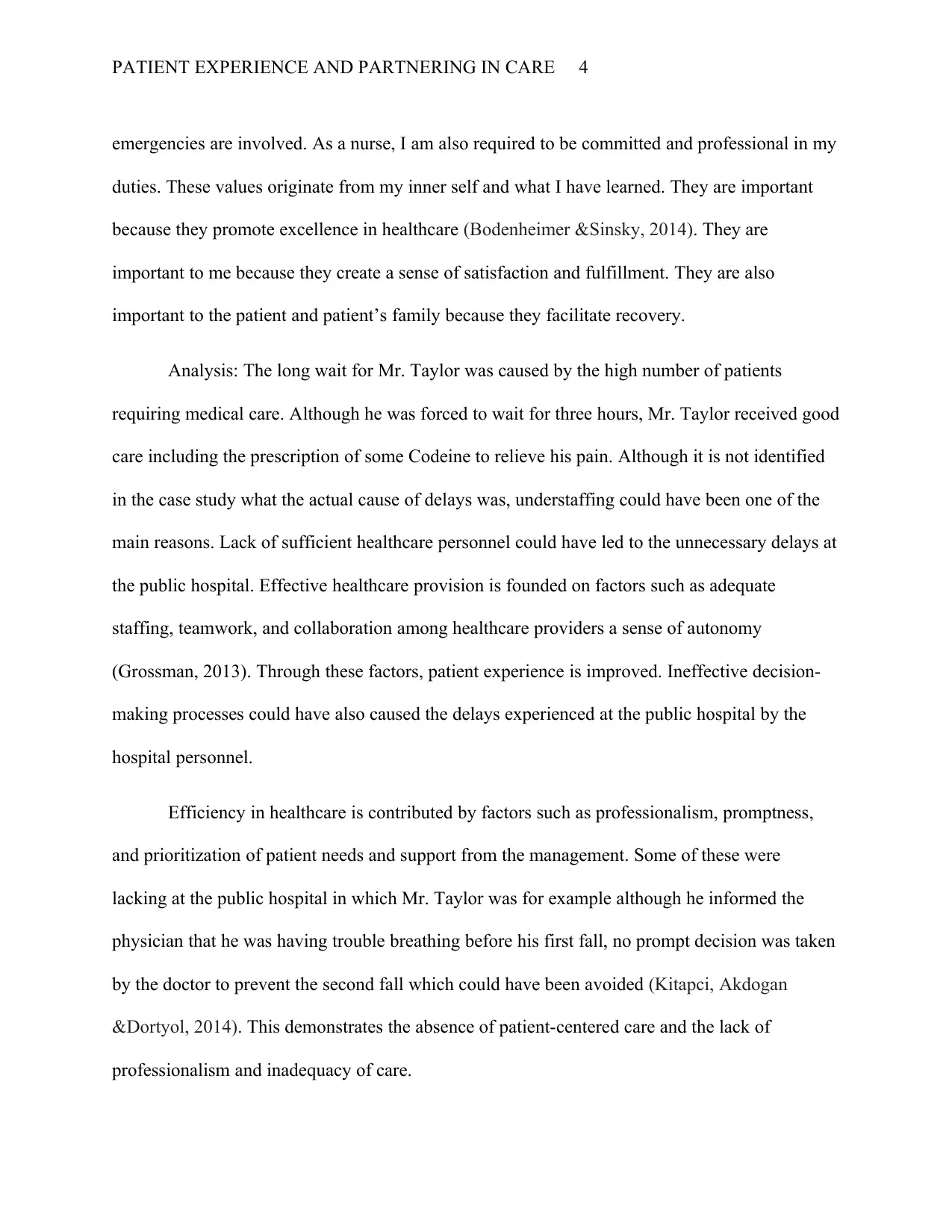
PATIENT EXPERIENCE AND PARTNERING IN CARE 4
emergencies are involved. As a nurse, I am also required to be committed and professional in my
duties. These values originate from my inner self and what I have learned. They are important
because they promote excellence in healthcare (Bodenheimer &Sinsky, 2014). They are
important to me because they create a sense of satisfaction and fulfillment. They are also
important to the patient and patient’s family because they facilitate recovery.
Analysis: The long wait for Mr. Taylor was caused by the high number of patients
requiring medical care. Although he was forced to wait for three hours, Mr. Taylor received good
care including the prescription of some Codeine to relieve his pain. Although it is not identified
in the case study what the actual cause of delays was, understaffing could have been one of the
main reasons. Lack of sufficient healthcare personnel could have led to the unnecessary delays at
the public hospital. Effective healthcare provision is founded on factors such as adequate
staffing, teamwork, and collaboration among healthcare providers a sense of autonomy
(Grossman, 2013). Through these factors, patient experience is improved. Ineffective decision-
making processes could have also caused the delays experienced at the public hospital by the
hospital personnel.
Efficiency in healthcare is contributed by factors such as professionalism, promptness,
and prioritization of patient needs and support from the management. Some of these were
lacking at the public hospital in which Mr. Taylor was for example although he informed the
physician that he was having trouble breathing before his first fall, no prompt decision was taken
by the doctor to prevent the second fall which could have been avoided (Kitapci, Akdogan
&Dortyol, 2014). This demonstrates the absence of patient-centered care and the lack of
professionalism and inadequacy of care.
emergencies are involved. As a nurse, I am also required to be committed and professional in my
duties. These values originate from my inner self and what I have learned. They are important
because they promote excellence in healthcare (Bodenheimer &Sinsky, 2014). They are
important to me because they create a sense of satisfaction and fulfillment. They are also
important to the patient and patient’s family because they facilitate recovery.
Analysis: The long wait for Mr. Taylor was caused by the high number of patients
requiring medical care. Although he was forced to wait for three hours, Mr. Taylor received good
care including the prescription of some Codeine to relieve his pain. Although it is not identified
in the case study what the actual cause of delays was, understaffing could have been one of the
main reasons. Lack of sufficient healthcare personnel could have led to the unnecessary delays at
the public hospital. Effective healthcare provision is founded on factors such as adequate
staffing, teamwork, and collaboration among healthcare providers a sense of autonomy
(Grossman, 2013). Through these factors, patient experience is improved. Ineffective decision-
making processes could have also caused the delays experienced at the public hospital by the
hospital personnel.
Efficiency in healthcare is contributed by factors such as professionalism, promptness,
and prioritization of patient needs and support from the management. Some of these were
lacking at the public hospital in which Mr. Taylor was for example although he informed the
physician that he was having trouble breathing before his first fall, no prompt decision was taken
by the doctor to prevent the second fall which could have been avoided (Kitapci, Akdogan
&Dortyol, 2014). This demonstrates the absence of patient-centered care and the lack of
professionalism and inadequacy of care.
Paraphrase This Document
Need a fresh take? Get an instant paraphrase of this document with our AI Paraphraser
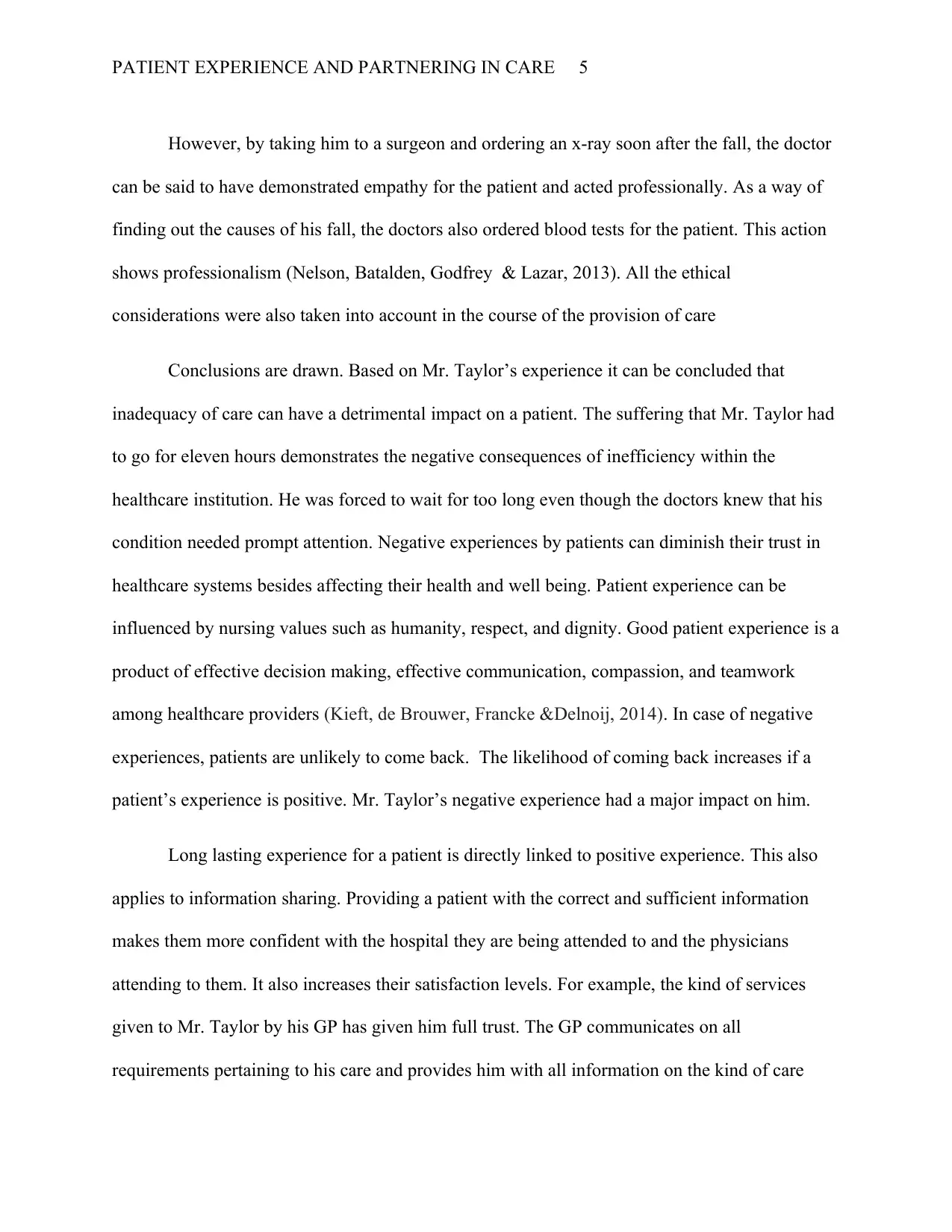
PATIENT EXPERIENCE AND PARTNERING IN CARE 5
However, by taking him to a surgeon and ordering an x-ray soon after the fall, the doctor
can be said to have demonstrated empathy for the patient and acted professionally. As a way of
finding out the causes of his fall, the doctors also ordered blood tests for the patient. This action
shows professionalism (Nelson, Batalden, Godfrey & Lazar, 2013). All the ethical
considerations were also taken into account in the course of the provision of care
Conclusions are drawn. Based on Mr. Taylor’s experience it can be concluded that
inadequacy of care can have a detrimental impact on a patient. The suffering that Mr. Taylor had
to go for eleven hours demonstrates the negative consequences of inefficiency within the
healthcare institution. He was forced to wait for too long even though the doctors knew that his
condition needed prompt attention. Negative experiences by patients can diminish their trust in
healthcare systems besides affecting their health and well being. Patient experience can be
influenced by nursing values such as humanity, respect, and dignity. Good patient experience is a
product of effective decision making, effective communication, compassion, and teamwork
among healthcare providers (Kieft, de Brouwer, Francke &Delnoij, 2014). In case of negative
experiences, patients are unlikely to come back. The likelihood of coming back increases if a
patient’s experience is positive. Mr. Taylor’s negative experience had a major impact on him.
Long lasting experience for a patient is directly linked to positive experience. This also
applies to information sharing. Providing a patient with the correct and sufficient information
makes them more confident with the hospital they are being attended to and the physicians
attending to them. It also increases their satisfaction levels. For example, the kind of services
given to Mr. Taylor by his GP has given him full trust. The GP communicates on all
requirements pertaining to his care and provides him with all information on the kind of care
However, by taking him to a surgeon and ordering an x-ray soon after the fall, the doctor
can be said to have demonstrated empathy for the patient and acted professionally. As a way of
finding out the causes of his fall, the doctors also ordered blood tests for the patient. This action
shows professionalism (Nelson, Batalden, Godfrey & Lazar, 2013). All the ethical
considerations were also taken into account in the course of the provision of care
Conclusions are drawn. Based on Mr. Taylor’s experience it can be concluded that
inadequacy of care can have a detrimental impact on a patient. The suffering that Mr. Taylor had
to go for eleven hours demonstrates the negative consequences of inefficiency within the
healthcare institution. He was forced to wait for too long even though the doctors knew that his
condition needed prompt attention. Negative experiences by patients can diminish their trust in
healthcare systems besides affecting their health and well being. Patient experience can be
influenced by nursing values such as humanity, respect, and dignity. Good patient experience is a
product of effective decision making, effective communication, compassion, and teamwork
among healthcare providers (Kieft, de Brouwer, Francke &Delnoij, 2014). In case of negative
experiences, patients are unlikely to come back. The likelihood of coming back increases if a
patient’s experience is positive. Mr. Taylor’s negative experience had a major impact on him.
Long lasting experience for a patient is directly linked to positive experience. This also
applies to information sharing. Providing a patient with the correct and sufficient information
makes them more confident with the hospital they are being attended to and the physicians
attending to them. It also increases their satisfaction levels. For example, the kind of services
given to Mr. Taylor by his GP has given him full trust. The GP communicates on all
requirements pertaining to his care and provides him with all information on the kind of care
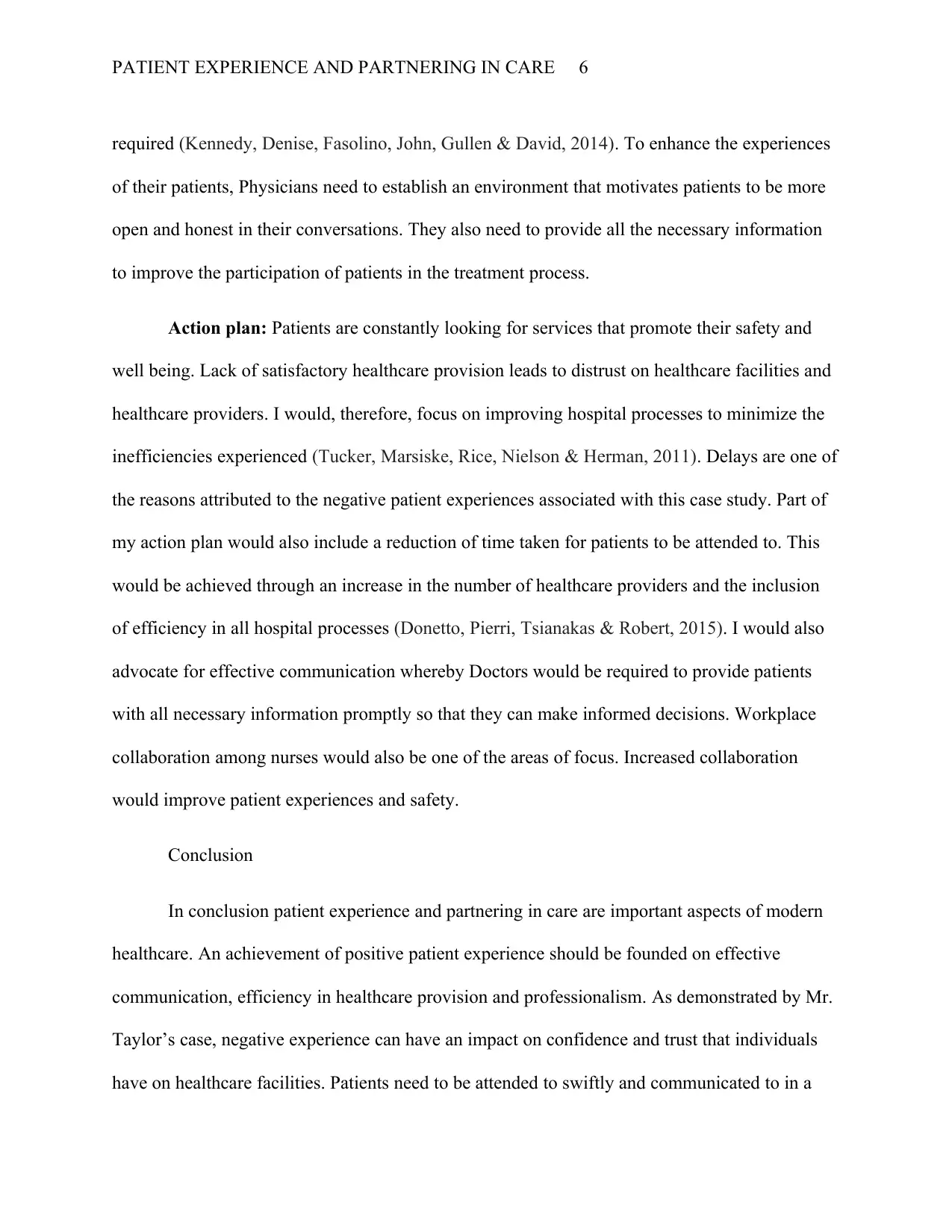
PATIENT EXPERIENCE AND PARTNERING IN CARE 6
required (Kennedy, Denise, Fasolino, John, Gullen & David, 2014). To enhance the experiences
of their patients, Physicians need to establish an environment that motivates patients to be more
open and honest in their conversations. They also need to provide all the necessary information
to improve the participation of patients in the treatment process.
Action plan: Patients are constantly looking for services that promote their safety and
well being. Lack of satisfactory healthcare provision leads to distrust on healthcare facilities and
healthcare providers. I would, therefore, focus on improving hospital processes to minimize the
inefficiencies experienced (Tucker, Marsiske, Rice, Nielson & Herman, 2011). Delays are one of
the reasons attributed to the negative patient experiences associated with this case study. Part of
my action plan would also include a reduction of time taken for patients to be attended to. This
would be achieved through an increase in the number of healthcare providers and the inclusion
of efficiency in all hospital processes (Donetto, Pierri, Tsianakas & Robert, 2015). I would also
advocate for effective communication whereby Doctors would be required to provide patients
with all necessary information promptly so that they can make informed decisions. Workplace
collaboration among nurses would also be one of the areas of focus. Increased collaboration
would improve patient experiences and safety.
Conclusion
In conclusion patient experience and partnering in care are important aspects of modern
healthcare. An achievement of positive patient experience should be founded on effective
communication, efficiency in healthcare provision and professionalism. As demonstrated by Mr.
Taylor’s case, negative experience can have an impact on confidence and trust that individuals
have on healthcare facilities. Patients need to be attended to swiftly and communicated to in a
required (Kennedy, Denise, Fasolino, John, Gullen & David, 2014). To enhance the experiences
of their patients, Physicians need to establish an environment that motivates patients to be more
open and honest in their conversations. They also need to provide all the necessary information
to improve the participation of patients in the treatment process.
Action plan: Patients are constantly looking for services that promote their safety and
well being. Lack of satisfactory healthcare provision leads to distrust on healthcare facilities and
healthcare providers. I would, therefore, focus on improving hospital processes to minimize the
inefficiencies experienced (Tucker, Marsiske, Rice, Nielson & Herman, 2011). Delays are one of
the reasons attributed to the negative patient experiences associated with this case study. Part of
my action plan would also include a reduction of time taken for patients to be attended to. This
would be achieved through an increase in the number of healthcare providers and the inclusion
of efficiency in all hospital processes (Donetto, Pierri, Tsianakas & Robert, 2015). I would also
advocate for effective communication whereby Doctors would be required to provide patients
with all necessary information promptly so that they can make informed decisions. Workplace
collaboration among nurses would also be one of the areas of focus. Increased collaboration
would improve patient experiences and safety.
Conclusion
In conclusion patient experience and partnering in care are important aspects of modern
healthcare. An achievement of positive patient experience should be founded on effective
communication, efficiency in healthcare provision and professionalism. As demonstrated by Mr.
Taylor’s case, negative experience can have an impact on confidence and trust that individuals
have on healthcare facilities. Patients need to be attended to swiftly and communicated to in a
⊘ This is a preview!⊘
Do you want full access?
Subscribe today to unlock all pages.

Trusted by 1+ million students worldwide
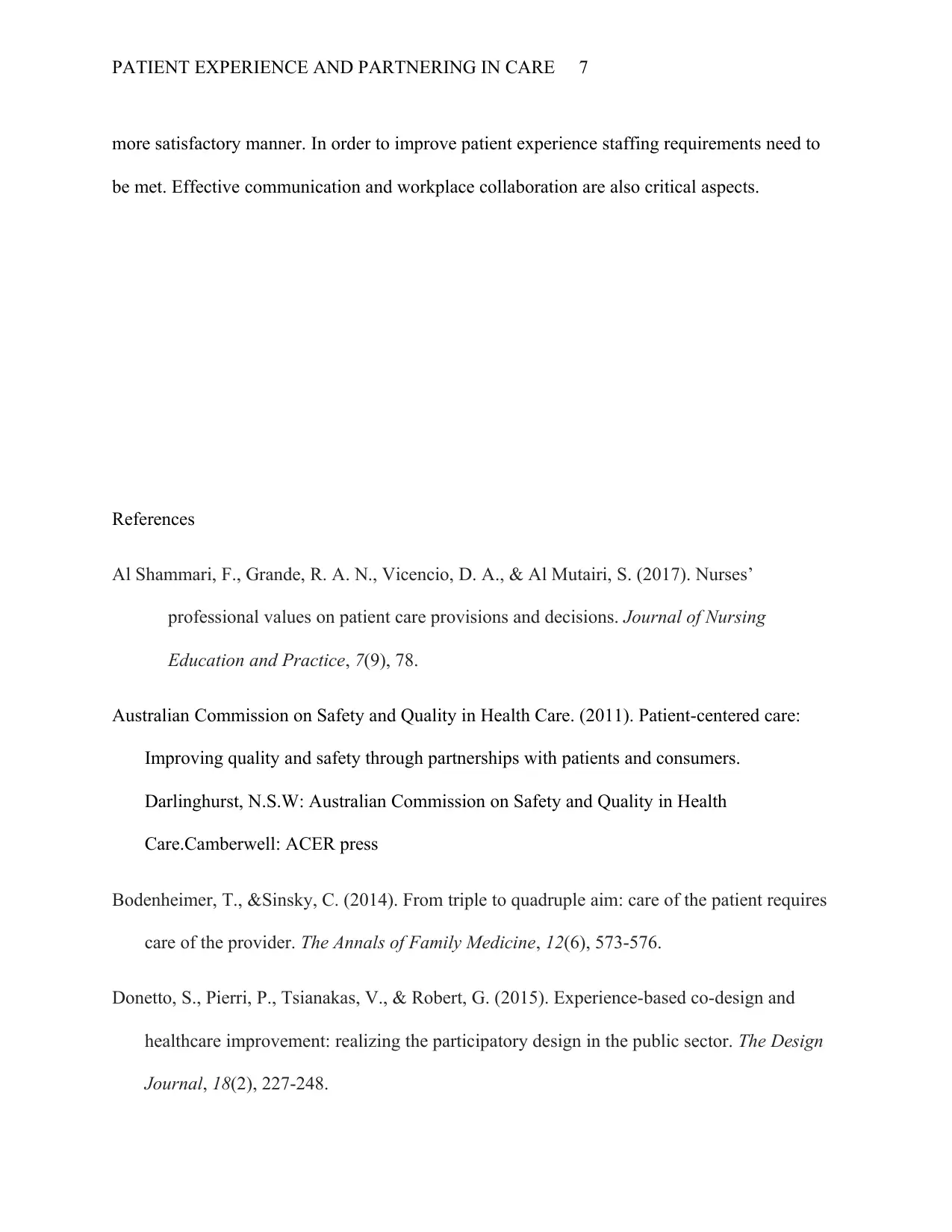
PATIENT EXPERIENCE AND PARTNERING IN CARE 7
more satisfactory manner. In order to improve patient experience staffing requirements need to
be met. Effective communication and workplace collaboration are also critical aspects.
References
Al Shammari, F., Grande, R. A. N., Vicencio, D. A., & Al Mutairi, S. (2017). Nurses’
professional values on patient care provisions and decisions. Journal of Nursing
Education and Practice, 7(9), 78.
Australian Commission on Safety and Quality in Health Care. (2011). Patient-centered care:
Improving quality and safety through partnerships with patients and consumers.
Darlinghurst, N.S.W: Australian Commission on Safety and Quality in Health
Care.Camberwell: ACER press
Bodenheimer, T., &Sinsky, C. (2014). From triple to quadruple aim: care of the patient requires
care of the provider. The Annals of Family Medicine, 12(6), 573-576.
Donetto, S., Pierri, P., Tsianakas, V., & Robert, G. (2015). Experience-based co-design and
healthcare improvement: realizing the participatory design in the public sector. The Design
Journal, 18(2), 227-248.
more satisfactory manner. In order to improve patient experience staffing requirements need to
be met. Effective communication and workplace collaboration are also critical aspects.
References
Al Shammari, F., Grande, R. A. N., Vicencio, D. A., & Al Mutairi, S. (2017). Nurses’
professional values on patient care provisions and decisions. Journal of Nursing
Education and Practice, 7(9), 78.
Australian Commission on Safety and Quality in Health Care. (2011). Patient-centered care:
Improving quality and safety through partnerships with patients and consumers.
Darlinghurst, N.S.W: Australian Commission on Safety and Quality in Health
Care.Camberwell: ACER press
Bodenheimer, T., &Sinsky, C. (2014). From triple to quadruple aim: care of the patient requires
care of the provider. The Annals of Family Medicine, 12(6), 573-576.
Donetto, S., Pierri, P., Tsianakas, V., & Robert, G. (2015). Experience-based co-design and
healthcare improvement: realizing the participatory design in the public sector. The Design
Journal, 18(2), 227-248.
Paraphrase This Document
Need a fresh take? Get an instant paraphrase of this document with our AI Paraphraser
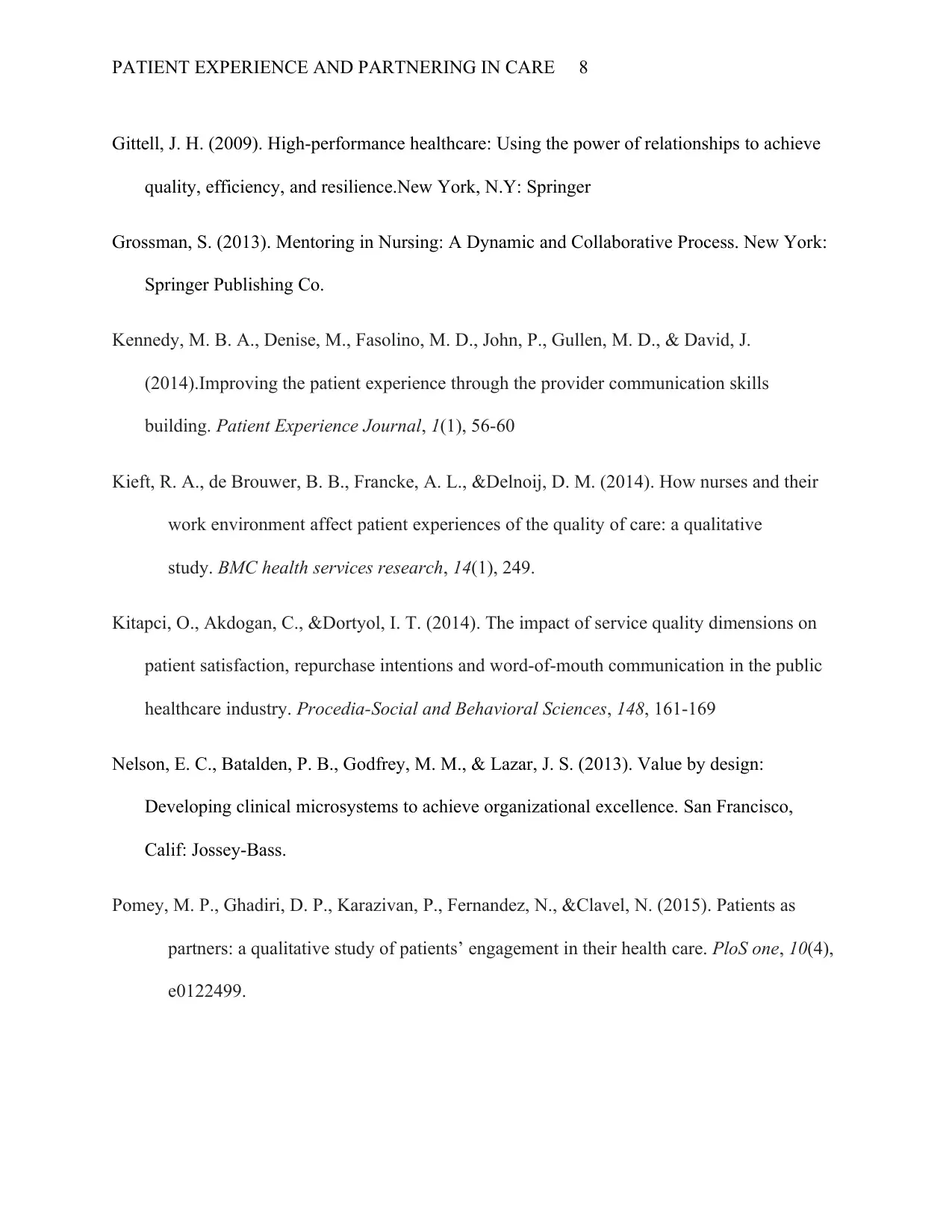
PATIENT EXPERIENCE AND PARTNERING IN CARE 8
Gittell, J. H. (2009). High-performance healthcare: Using the power of relationships to achieve
quality, efficiency, and resilience.New York, N.Y: Springer
Grossman, S. (2013). Mentoring in Nursing: A Dynamic and Collaborative Process. New York:
Springer Publishing Co.
Kennedy, M. B. A., Denise, M., Fasolino, M. D., John, P., Gullen, M. D., & David, J.
(2014).Improving the patient experience through the provider communication skills
building. Patient Experience Journal, 1(1), 56-60
Kieft, R. A., de Brouwer, B. B., Francke, A. L., &Delnoij, D. M. (2014). How nurses and their
work environment affect patient experiences of the quality of care: a qualitative
study. BMC health services research, 14(1), 249.
Kitapci, O., Akdogan, C., &Dortyol, I. T. (2014). The impact of service quality dimensions on
patient satisfaction, repurchase intentions and word-of-mouth communication in the public
healthcare industry. Procedia-Social and Behavioral Sciences, 148, 161-169
Nelson, E. C., Batalden, P. B., Godfrey, M. M., & Lazar, J. S. (2013). Value by design:
Developing clinical microsystems to achieve organizational excellence. San Francisco,
Calif: Jossey-Bass.
Pomey, M. P., Ghadiri, D. P., Karazivan, P., Fernandez, N., &Clavel, N. (2015). Patients as
partners: a qualitative study of patients’ engagement in their health care. PloS one, 10(4),
e0122499.
Gittell, J. H. (2009). High-performance healthcare: Using the power of relationships to achieve
quality, efficiency, and resilience.New York, N.Y: Springer
Grossman, S. (2013). Mentoring in Nursing: A Dynamic and Collaborative Process. New York:
Springer Publishing Co.
Kennedy, M. B. A., Denise, M., Fasolino, M. D., John, P., Gullen, M. D., & David, J.
(2014).Improving the patient experience through the provider communication skills
building. Patient Experience Journal, 1(1), 56-60
Kieft, R. A., de Brouwer, B. B., Francke, A. L., &Delnoij, D. M. (2014). How nurses and their
work environment affect patient experiences of the quality of care: a qualitative
study. BMC health services research, 14(1), 249.
Kitapci, O., Akdogan, C., &Dortyol, I. T. (2014). The impact of service quality dimensions on
patient satisfaction, repurchase intentions and word-of-mouth communication in the public
healthcare industry. Procedia-Social and Behavioral Sciences, 148, 161-169
Nelson, E. C., Batalden, P. B., Godfrey, M. M., & Lazar, J. S. (2013). Value by design:
Developing clinical microsystems to achieve organizational excellence. San Francisco,
Calif: Jossey-Bass.
Pomey, M. P., Ghadiri, D. P., Karazivan, P., Fernandez, N., &Clavel, N. (2015). Patients as
partners: a qualitative study of patients’ engagement in their health care. PloS one, 10(4),
e0122499.
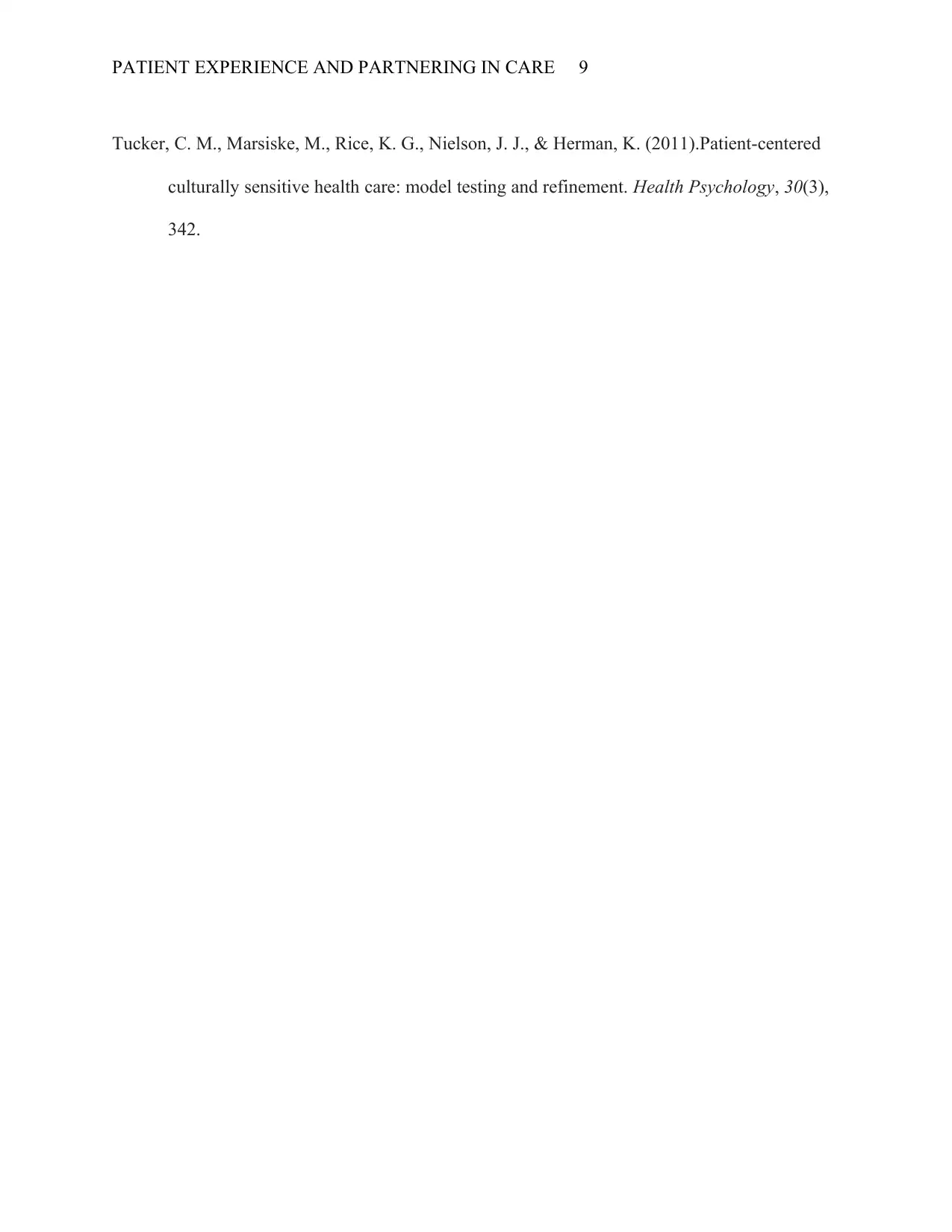
PATIENT EXPERIENCE AND PARTNERING IN CARE 9
Tucker, C. M., Marsiske, M., Rice, K. G., Nielson, J. J., & Herman, K. (2011).Patient-centered
culturally sensitive health care: model testing and refinement. Health Psychology, 30(3),
342.
Tucker, C. M., Marsiske, M., Rice, K. G., Nielson, J. J., & Herman, K. (2011).Patient-centered
culturally sensitive health care: model testing and refinement. Health Psychology, 30(3),
342.
⊘ This is a preview!⊘
Do you want full access?
Subscribe today to unlock all pages.

Trusted by 1+ million students worldwide
1 out of 9
Related Documents
Your All-in-One AI-Powered Toolkit for Academic Success.
+13062052269
info@desklib.com
Available 24*7 on WhatsApp / Email
![[object Object]](/_next/static/media/star-bottom.7253800d.svg)
Unlock your academic potential
Copyright © 2020–2025 A2Z Services. All Rights Reserved. Developed and managed by ZUCOL.



